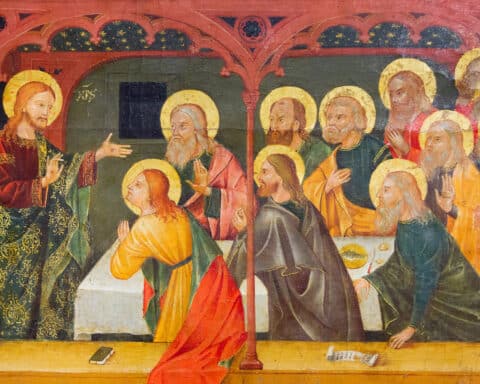Dear Friend,
I teach a course on theology and art. Some of my students are hesitant to analyze art, thinking that their insights will be superficial or unsophisticated. Others are a little too eager to interpret; they assume every interpretation is equally legitimate. No matter where the students begin, they must learn to start with what you see.
Starting with what you see is not simple. The first assignment teaches them that. They spend three hours looking at one seemingly uncomplicated piece of art. I call this assignment the “Intense Look,” and the whole point is just to see the painting you have selected. Students keep a journal of their viewing periods, tracking what they notice and when.
Students typically begin with a bit of fear, then move to boredom, then more boredom, but eventually strange things start happening. They begin noticing symmetries in the painting they hadn’t seen before, like a piece of fruit being the exact same shape as a gown’s ruffle. They notice connections that had been invisible to them, like a missing piece of pie on the table giving the appearance of a clock moving toward midnight … in a painting about mortality. Possibilities for meaning and significance emerge. After three hours, the piece of art is not what the students expected.
This example is not likely to “sell you” on a similar practice. As you hopefully know by now, though, I am not interested in selling you anything; instead, I want to speak to you truthfully about things that matter.
Reading Scripture matters. Just like learning to “read” a piece of art, reading Scripture well starts with what we see. But just like my students standing in front of the paintings, seeing well takes time, effort and humility on our part, because the word of God means to change us.
Eating the word
There is a peculiar passage of Scripture that shows us what it means to really read Scripture. It is from the Book of the Prophet Ezekiel:
“It was then I saw a hand stretched out to me; in it was a written scroll. He unrolled it before me; it was covered with writing front and back. … He said to me: Son of man, eat what you find here: eat this scroll, then go, speak to the house of Israel. So I opened my mouth, and he gave me the scroll to eat. Son of man, he said to me, feed your stomach and fill your belly with this scroll I am giving you. I ate it, and it was as sweet as honey in my mouth. … Then he said to me, Son of man, take into your heart all my words that I speak to you; hear them well” (Ez 2:9-3:3, 3:10)
Let’s see what is going on here. The prophet receives a scroll and is told to eat it. Maybe you have heard people say about a book, “I just couldn’t put it down; I devoured it!” They were so engrossed in what they were reading that they “consumed” the written word until they had their fill. Ezekiel is told to consume like that. Ezekiel is scrolling, but not like we “scroll.”
To “eat” or “consume” rules out from the start a kind of passive, distant observance of the written word. We know what passive reading is like: that’s how we “scroll,” or skim something. But here, the prophet is told to go all in. Give your full attention to this: Eat it up.
To fill your belly and digest what is written means to ruminate on these words. Think about when you have a big meal: it takes time to digest what you have eaten. The food affects you as your body works on it. Now think about something a friend might say to you that “sticks with you” for a good or bad reason. You “work it over” in your mind, you keep thinking about it, you “ruminate” on it. So, too, here with the word of God: Take it in, don’t quickly forget it, work it over.
To taste the sweetness of what you read or hear is to savor the sound of the words, find richness in the meaning. For Ezekiel, these words may not be the kind of thing he already likes, so he has to work to develop a taste for this sort of thing.
In the end, it is about receiving these words “in your heart.” That means to be changed by them. Where there is sorrow in these words, you, too, should experience sorrow. Where there is joy, experience joy. Where there is concern, be concerned. Where there is anger, anger. If you think about empathic listening, where you share in the mood and emotions of a dear friend, then you have a pretty good sense for what is being said here.
What this means for our reading
The prophet Ezekiel is like one of my students standing in front of a piece of art. He immerses himself in what he encounters. He takes the time to notice things that weren’t immediately apparent. He goes through ups and downs in the encounter, “digesting” what he takes in. And at the end of his encounter, he is not the same person he was when he started: The word changed him in his mind, heart and imagination.
To read Scripture well, we must pay attention and open ourselves to being changed.
The point of Scripture is not to give you what you want but rather to give you the Word of God: the one we need. He means to change us into his likeness, forming us to care about what he cares about, to feel sorrow for his sorrow, to rejoice in what he rejoices in. This is almost completely the opposite of our modern “scrolling,” where we just breeze by, looking for what we want and what pleases or entertains us.
Develop the skill
I offer you two quick suggestions for how to develop in the skill of reading Scripture.
First, engage your imagination. Take one scene from the Gospels and spend at least 30 minutes on two different days picturing the scene and placing yourself in it. Taking the time to apply your imagination — building images, constructing a scene — allows your own creativity to be applied to the word of God. This work creates an impression on you, and that impression often stays with you. You will likely discover or “notice” things you didn’t expect. The key here is to start with the biblical passage, read it over several times, then slowly imagine the scene, select a place within it and see, hear, feel, smell and taste what is happening. Stay with one episode for at least two days, and end each session with a one-page journal entry to record what you encountered.
Second, allow Scripture to remap your mind. For this, you need a Bible that includes annotations (references to other parts of Scripture, usually in the footnotes). Choose a book of the Bible. Do not read it quickly. Instead, set out to read at most one chapter in a day. The key is to follow the annotations in the footnotes of your Bible to read other parts of Scripture that relate to a given verse or episode. For example, if you read the Passion narratives in one of the Gospels, you will be regularly directed back to the psalms. Follow those references. Read the verse in the psalms that directly relates to the passage you read in the Gospel, then feel free to read more of the psalm. See how your understanding of the Gospel passage is being enriched, challenged or stretched by what you are reading elsewhere. In this way, you allow Scripture to educate you and create for you a mental map across multiple books. Be sure to keep a reading journal — this is hugely important.
These two practices may be used together, or you may practice one for a season, then the other for another season. These are, of course, not the only two practices, but they are good ones, and each will incline you to start with what you see, then learn to see better — and ultimately be changed by the Word of God who speaks to you.
Sincerely,
Leonard J. DeLorenzo, Ph.D., works in the McGrath Institute for Church Life and teaches theology at the University of Notre Dame. Subscribe to his weekly newsletter, “Life, Sweetness, Hope,” at bit.ly/lifesweetnesshope.






